
11 minute read
NH Cities and Towns on the Rise
Even here in the best state in the country (our opinion, but heartfelt ) cities riseand fall over time. But some places don’t take the changes lying down and choose to take charge of their futures. Like these...
BY BARBARA COLES, PHOTO BY JOE KLEMENTOVICH
The stories are similar — once-vibrant New Hampshire downtowns, humming with com merce, decay into a place of empty storefronts, becoming shabbier by the day. It is a do wnward spiral that many, if not most, of the state’s cities and towns have witnessed over the years. Much of the decline started when the mills moved south in the ’60s and ’70s. Recessions later played a part. So did the arrival of malls and online shopping.
But, like the green plant that grows in the crevice of a rock, cities and towns, one by one, gained new life. It wasn’t easy; it took considerable resources, determined leadership and a ton of community spirit. Here, we profile three cities and two towns that are among the most successful.
LITTLETON
Maybe Littleton took a cue from Pollyanna, the irrepressibly optimistic girl in the well-known children’s stories written by Littleton native Eleanor H. Porter. In the midst of the downtown, to mark Porter’s literary achievement, there’s a bronze statue of Pollyanna, arms flung wide, looking like she is welcoming all that is good.
And, for the 20 years the statue has stood there, there has been a whole lot of good happening and Littletonians are, well, optimistic that there will be more coming.
Not long before the statue was put in place, Littleton had become one of the first New Hampshire communities to institute the national Main Street program to help revitalize a downtown that had a 20% vacancy rate. Fast forward to today — the recent vacancy rate, the clearest measure of a town’s vitality, has been at a high of 5% and a low of 2%.
Along the way, Littleton received the honor of becoming one of only t wo New Hampshire towns

From left: Miller’s Café & Bakery, the original Schilling Beer Co. brewpub and Schilling’s new tasting room and production facility all overlook the Ammonoosuc River in Littleton.
Photo by Joe Klementovich

(Milford is the other) that have been named a Great American Main Street Community, a coveted and competitive national award given by the National Trust for Historic Preservation.
Littleton is not just a vibrant Main Street with attractions like the world’s lon- gest candy counter (112 feet!) at Chutters a nd entertainment at the historic Opera House; it has another trove of activity along the Ammonoosuc River, which parallels Main Street.
Among the businesses in what is called the River District, developed in recent years, is the Schilling Beer Co. in a con- verted 18th-century riverside gristmill, the L eague’s Littleton Gallery and the Riverwalk covered bridge. There’s also the Tannery Marketplace, a reconstituted 1878 tan- nery building, which has numerous small b usinesses, both retail and professional, occupying its 30,000 square feet of space.
“Littleton is an exciting place to be,” says Charles Mullen, manager of the Tannery Marketplace. “I call it the New York City of the North Country.”
That excitement is drawing a lot of young people to the town, a significant accom- plishment in an aging state. It doesn’t hurt t hat the town is just off I-93 and close to all that the White Mountains can offer.
Five years ago, The Boston Globe described Littleton as “teetering on the edge of hipness.” Today, most agree, it’s no longer teetering.

Schilling Beer Co.’s modern tasting room and production facility complements the original brewpub, which is located in one of the oldest commercial buildings north of Concord. The former gristmill dates back to the 18th century.
ROCHESTER
This is the month when Rochester demonstrates why it’s called the “Lilac City” with its annual array of lavender. Against that backdrop of color is a down town that’s blossoming itself, with empty s torefronts filling up with new businesses one by one, bringing down a vacancy rate that was once sky-high.
Rochester’s growing vibrancy was evident enough this magazine dubbed it a “City on the Rise” in the 2018 Best of NH issue. Noted was “a significant grassroots movement to bootstrap the city into prominence as a center for art, culture, dining and economic vitality.”
Part of the grassroots movement is Todd Radict, owner of Skele-Tone Records and one of the organizers of Rochester Rise Up, a group of store owners, community members and city officials that meet to determine ways to beautify Rochester. “If your city doesn’t look inviting, nobody’s going to come,” he says. Sprucing up buildings, cleaning streets and sidewalks, increasing pedestrian safety and adding color are just a few examples of what’s been done. “There’s a very good vibe around Rochester now,” Radict says.
Rochester also benefited by being part of the Main Street program, starting in 2006. “Multiple organizations are working to get the city cleaned up,” says Angela Mills, executive director of Rochester Main Street. “It’s a win-win for everyone.”

Between the Rochester Opera House, parades, eye-catching stores and plentiful dining options, Rochester has a little bit of everything for visitors.
She credits city officials with providing the tools for new development. “They’re coming at it from multiple directions,” Mills says. Among the tools, financial help with grants and loans as well as changes in city ordinances to lessen red tape and encourage more downtown residential development. “Now someone might be able to create 20 apartments instead of three,” she says, a change that can increase the foot traffic important to downtown businesses.
Also increasing foot traffic, the many events the city has, including free comic book day, the gay pride parade and the Christmas parade. Another big draw is the once-dilapidated 1908 Opera House, with its one-of-a-kind movable floor. In the late 1990s, it was restored through volunteer efforts and fundraising; it now hosts internationally recognized artists.
“I think people are now realizing the value of a healthy and vibrant downtown,” Mills says.

Rochester Opera House
MILFORD
It wasn’t so long ago that you wouldn’t have seen world cuisine offered in Milford. “It was a little out-of-the-box,” says Rachael Barnard, co-owner of La Medina, which offers world cuisine. But she knew that diners in Milford and the surrounding area had grown more sophisticated and would support the venture.
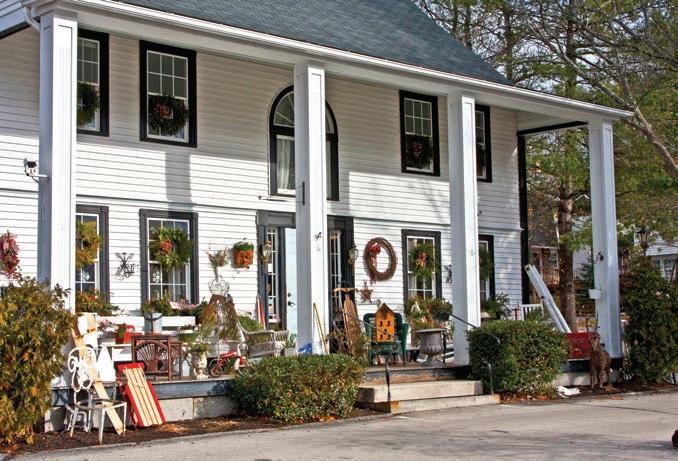
Below: Vynterest Antiques and Flips will be opening their new Barn on Savage Farm location in June 2020.
Courtesy photo
Her restaurant is one of many that have opened their doors in Milford in recent years. Of note as well is Greenleaf, operated by a pair of restaurateurs renowned in the state. Chef Chris Viaud and Keith Sarasin, sensitive to the preservation of historic places, chose a circa 1860 downtown bank building for the restaurant.

The Milford Pumpkin Festival draws tens of thousands of visitors to the town’s downtown every year.
Courtesy photo
It’s that type of preservation that many cities and towns hope for. “It preserves a piece of history,” says Lincoln Daley, Milford’s director of community development. He adds that the burgeoning number of restaurants in Milford provides the opportunity for other businesses to build on the foot traffic the restaurants generate. “It’s a nice little hot spot for businesses,” he says. One reason Milford is a hot spot is its prime location, close to Nashua and Manchester, not far from the Massachusetts line.
Back in the 1980s, it was a very different scene. According to the Milford Improvement Team website, Milford had just a few struggling businesses, deteriorating public ways and a reputation as a gathering spot for drug dealers. When the historic town hall was close to being condemned by the State Fire Marshall, the community responded by approving funds to restore it.
That was a catalyst for change. Grassroots initiatives, like making the popular pumpkin festival an annual event, began. Those efforts were formalized in a citizens’ group that eventually merged with Main Street America, a program established by the National Trust for Historic Preservation to address the issues facing older and historic downtowns.
Part of the Main Street program, which has successfully been used in many New Hampshire communities, focuses on improving the appearance of downtowns. In Milford, it meant brick sidewalks, attractive lighting and improving pedestrian movement around the downtown’s ring of stores — the “oval,” as they say in Milford. Lincoln Daley says, “First impressions count. For many people, the downtown is the first impression of a town or city.”
CLAREMONT
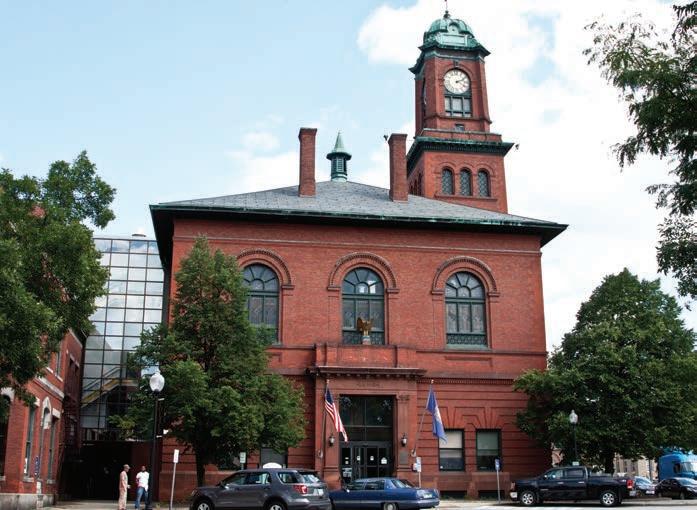
Since its grand reopening in 1979, the Opera House has become the entertainment center of the area with a full calendar of programming ranging from comedy shows to plays.
Photo by Stilman Rogers
It was just before the Revolutionary War that Col. Benjamin Tyler built the first mill on the Sugar River in the Colonial settlement of Claremont. Many more mills would be built along the river and Claremont became a prosperous city. In 1897, the Opera House, its crown jewel to this day, was built.
A century later, Claremont was in dire straits, having followed the same trajectory as other aging cities, succumbing to the weight of economic dislocations. The long-abandoned mills along the river were slated to be torn down. The city was nearly bankrupt. Three city managers had come and gone in the space of a year.
“It was a desperate time,” says Guy Santagate, who became last in the string of city managers in 2001. He had come at the behest of a citizens’ committee that knew the city was in trouble and hoped his consider able experience could produce a turnaround.
Sa ntagate started with what he felt could be the key to revitalization — the mills along the river, the ones the city was planning to tear down. After he convinced the city to wait, Santagate lured prospective developers to Claremont to take a look. “I knew it could be a beautiful property,” he says.
He also knew it would take someone with extraordinary vision to see the possibilities after walking past signs that warned the buildings were too danger ous to enter. Long story short, Alex Ray o f The Common Man fame and partner Rusty McLear built a restaurant and hotel there, a real draw for the city especially with the interstate nearby. There were other takers too, including the high-tech Red River company.
The revitalization of the mills — helped along financially by city, state and federal programs — provided the spark for the downtown to come alive.
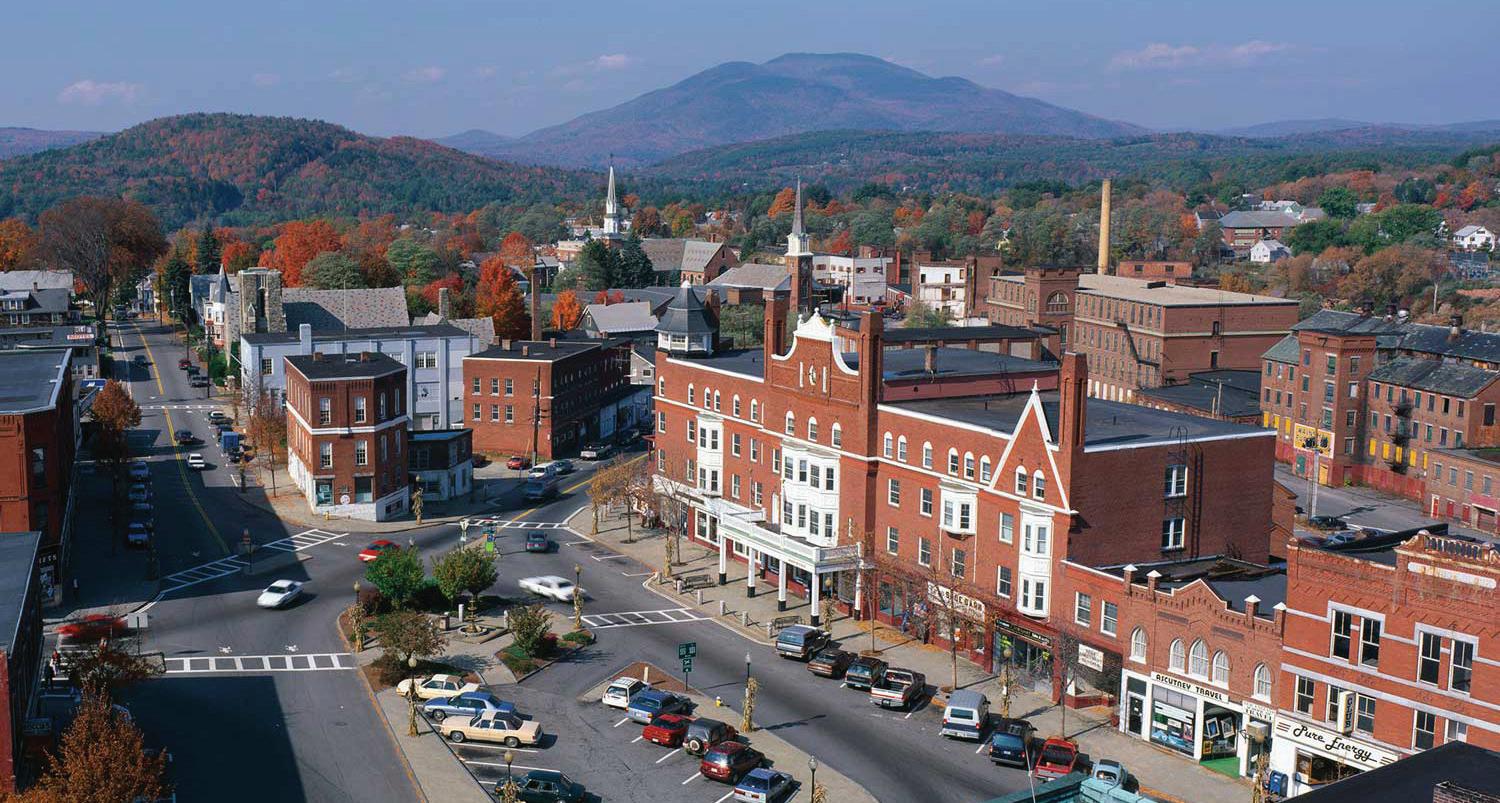
Downtown Claremont
One of the many businesses that would open its doors was Claremont Spice & Dry Goods. Ten years ago, Chiara Tosi-Nelson and her husband Benjamin bought the business and last year created a sister store, The Kitchen Drawer.
Benjamin had grown up in Claremont; his family had lived there for generations. Returning to Claremont, seeing it as a thriving city, made them happy to be part of it. Chiara says, “This is a place you want to come back to.”
LACONIA
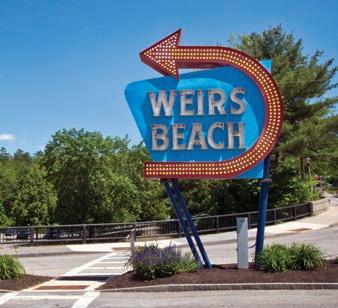
This world-famous neon sign features 696 11-watt chaser bulbs, 200 feet of neon tubing, and distinctively lights up to welcome visitors to Weirs Beach.
As other New Hampshire cities and towns started to rebound in recent years, Laconia lagged behind. It was, in large measure, because of actions taken a half-century ago that, while well inten tioned, hampered the city’s recovery.
One of those was a major urban renewal project in the 1970s that, among other things, created a difficult traffic pattern that discouraged downtown development. Another was a decision not to pursue a direct link to I-93.
For years, there were empty storefronts and little nightlife. Young people, vital to any city, left in droves. The median age shot up 20% between 2000 and 2016.
But, in 2017, an ambitious new master plan was formulated, one that would set the city on an upward trajectory for residential and commercial development. As a ci ty official put it at the time, it would be a plan with “well-worn pages,” not one “that sits on the shelf and gathers dust.” And so it was.
The city’s efforts were amplified by citizen initiatives like Celebrate Laconia. It was set up in 2018 to plan events to celebrate the city 125th anniversary, but its work soon went far beyond that. Jared Guilmett, one of the organizers, says the group’s mission was to be “a strong leader in increasing the vibrancy of the city.”
To help advance the mission, Laconia Talks was created. It’s a series of community conversations where residents ga ther to to talk about the city’s critical issues, among them how to bring young professionals to the city. Guilmett is hopeful that will happen: “Laconia is an attractive community and a lot of pieces are starting to fall into place. We want to find a way to lock them in.”
One of those pieces is the cultural activity that will be provided, starting late this year, by the Colonial Theatre. The century-old Main Street performance venue, long closed, is now being restored to its former elegance; it’s one of the largest historic preservation projects in state history.
“It is a strategic investment in the community to continue to build opportunity in Laconia,” says Justin Slattery, executive director of Belknap Economic Development Council, which spearheaded the multimillion-dollar financing of the project. “It’s really an anchor to the downtown.”
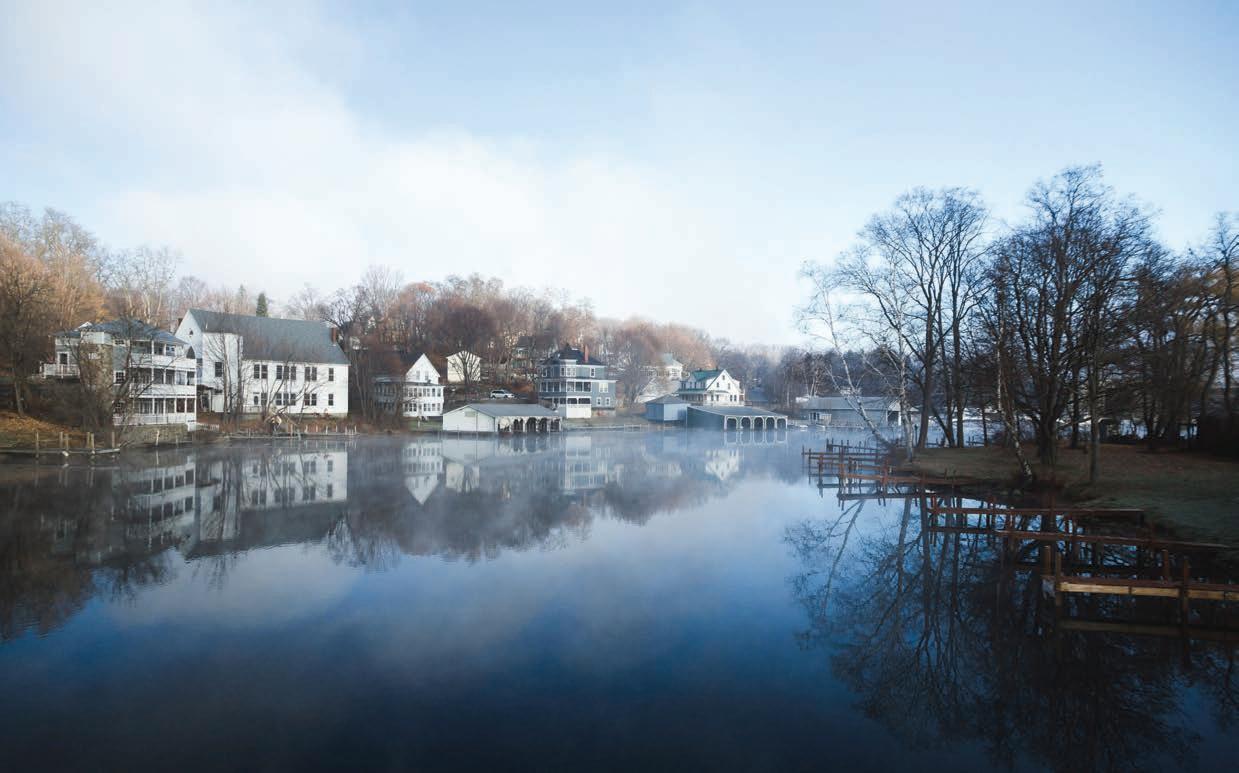
Motorcycle Week and the busy beach tend to come to mind when Laconia is mentioned, but it has a peaceful side too.
Photo by Rob Clifford
There are other draws as well. For nearly a century, Motorcycle Week has brought bikers from across the country to Weirs Beach, itself recently undergoing significant sprucing up. And now thousands more come to the New Hampshire Pumpkin Festival, which was moved to Laconia from Keene a few years ago.
“We’re seeing a lot of can-do attitude in the city,” says Slattery.
Guilmett agrees: “Laconia is an energized community, ready to break through and really become a strong force in the Lakes Region.”










